*** Proof of Product ***

Exploring the Essential Features of “Hans-Friedrich Mueller – Latin 101: Learning a Classical Language”
Latin 101: Learning a Classical Language
Discover the exciting intellectual challenge of Latin in this course that uses works by Cicero, Virgil, Caesar, and others to teach you the rules and form of this great language.
LESSON (36)
01:Pronouncing Classical Latin
Salvete! Greetings! Ease into your study of Latin by admiring its beauty and impressive history. Then focus on the letters and sounds of the restored classical pronunciation, which approximates the way Latin was spoken in the classical era. Finally, cover the rules of accents.
02:Introduction to Third-Conjugation Verbs
Begin your adventure in Latin verbs with the third conjugation, practicing the present tense indicative of ago (I do). Learn the four principal parts of ago-the key words that allow you to conjugate any form-as well as the imperative endings that permit you to issue commands.
03:Introduction to the Subjunctive Mood
See how the long vowel “a” is the key to the present subjunctive mood in verbs such as pono (I place). The subjunctive expresses doubt or potential, and you explore its use by the poet Catullus in one of the most famous love poems to survive from the ancient world.
04:The Irregular Verbs Sum and Possum
Learn two important irregular verbs, sum (I am) and possum (I am able), mastering their present tense indicative, imperative, infinitive, and subjunctive forms. Notice how the tiniest linguistic details can be powerful markers, giving rise to Latin’s great economy of expression.
05:Introduction to Third-Declension Nouns
Having conjugated verbs, now learn to decline nouns. In this lecture, investigate the largest class of nouns, called third declension. Discover the function of the five cases and how to identify the noun stem. Then practice with masculine and feminine nouns.
06:Third-Declension Neuter Nouns
After a review of verb and noun endings covered so far, focus on third- declension neuter nouns, specifically the word corpus (body). Note the distinctive features of the neuter declension, then practice these endings. Close by exploring several celebrated Latin expressions that feature corpus.
07:First- and Second-Declension Adjectives
Adjectives must agree in number, case, and gender with the nouns they modify. Review a chart of the endings for first- and second-declension adjectives. Then practice matching adjectives with nouns in examples such as nox perpetua (everlasting night) and basium fervidum (fiery kiss).
08:First- and Second-Declension Nouns
Study first- and second-declension nouns, discovering that they have the same endings as first- and second-declension adjectives-with some peculiarities. Close the lecture by translating your first complex sentence in Latin, which involves a shocking incident in Rome’s Temple of Vesta.
09:Introduction to the Passive Voice
See how the magic of personal endings makes the passive voice in Latin elegantly simple-unlike awkward passive constructions in English. After practicing the present tense passive indicative of the third conjugation, translate passages from the Roman authors Cicero and Virgil.
10:Third -io and Fourth-Conjugation Verbs
Investigate two classes of verbs similar to pono: the third-io and fourth conjugations. Learn the forms in the present tense active indicative. Then discover that you can understand the commands in the original Latin of the famous Christmas carol “O Come All Ye Faithful!”
11:First- and Second-Conjugation Verbs
Your knowledge of the third, third-io, and fourth conjugations paves the way for mastery of the remaining two patterns, the first and second conjugations, which are more regular than those already covered. Practice all five conjugations, and continue your translation of “O Come All Ye Faithful!”
12:Reading a Famous Latin Love Poem
Reap the rewards of your labors by reading and appreciating one of the most beautiful poems in Latin, which declares the poet Catullus’s love for Clodia, whom he calls Lesbia to hide her identity. In the poem, encounter many of the grammatical forms you have studied so far.
13:The Present Passive of All Conjugations
You have learned present passive forms in the third conjugation. Now cover the present passive endings in the first, second, third-io, and fourth conjugations. Close by deciphering a passage from the book of Genesis in St. Jerome’s Latin translation, and analyze a pagan prayer to the emperor Tiberius.
14:Third-Declension Adjectives
Dictionary entries for third-declension adjectives can be disconcertingly terse. Learn that these adjectives are actually easier to decline than first- and second-declension adjectives that you have already learned. Apply your new knowledge by declining Catullus’s phrase brevis lux (brief light) encountered in Lecture 12.
15:Third-Declension I-Stem Nouns
Explore a subset of third-declension nouns that has the letter “i” in certain forms. Called i-stems, these endings closely resemble those for third-declension adjectives. Expand your grasp of Latin morphology and syntax by reading passages from Cato the Elder, an arch-traditionalist of Roman values.
16:The Relative Pronoun
Pronouns that introduce a relative clause are called relative pronouns. Investigate these valuable words, which unlock the doors to Latin prose and are unusually enjoyable to chant aloud. Experience relative pronouns in action by translating two extracts from Sallust’s The Conspiracy of Catiline.
17:The Imperfect and Future Tenses
Having mastered the most challenging tense of all in Latin, the present tense, learn the future and imperfect tenses, which are governed by simpler rules. Practice the active and passive forms in all four conjugations. Also encounter the imperfect subjunctive.
18:Building Translation Skills
Apply your skills with the future and imperfect tenses to Latin texts. First, behold a lover’s quarrel in a poem by Catullus. Then, scrutinize a disingenuous claim by Julius Caesar. Next, read a brief passage from the Magna Carta, and close with two pithy sayings by Dionysius Cato.
19:Using the Subjunctive Mood
St. Jerome’s Latin translation of the Bible is an excellent text for beginning Latin students. Grasp the wisdom of Solomon by analyzing four verses from chapter 1 of the book of Proverbs. Your knowledge of Latin forms will enrich your understanding of these ancient sayings.
20:Demonstrative Adjectives and Pronouns
Study the three most basic demonstrative adjectives in Latin, and see how they can be used as pronouns. Then look at similar words that decline the same way. Close with a passage from Cicero that showcases the dramatic use of demonstrative adjective to indict a corrupt politician.
21:The Perfect Tense Active System
Tackle three new tenses: the perfect, pluperfect, and future perfect in the active voice. The perfect tense denotes completed action, contrasting with the uncompleted action of the imperfect, which you studied in Lecture 17. Finish by conjugating duco (I lead) for all of the active tenses learned so far.
22:Forming and Using Participles
Participles usefully combine characteristics of both verbs and adjectives. Learn the rules for forming Latin participles, and investigate some of their many applications. Close by translating the Latin from the Great Seal of the United States, which includes the perfect passive participle coeptus (having been begun).
23:Using the Infinitive
Enhance your knowledge of infinitives by learning perfect active and passive infinitives, as well as future active and passive infinitives. Then see how these forms are used for indirect discourse, which involves a crucial exception to the rule that subjects are always in the nominative case.
24:Reading a Passage from Caesar
With judicious help, you are now ready to read significant extracts of authentic Latin prose. Work through three sentences from Caesar’s Commentaries on the Gallic War. This exciting narrative is written in a direct, eloquent style that has enthralled readers for 2,000 years.
25:The Perfect Tense Passive System
Complete all the tenses of the Latin verb by learning the perfect passive, which uses a form of the verb sum together with the past participle. Close with an example of this construction in an ancient historian’s description of Caesar’s notorious death.
26:Deponent Verbs
The phrase non sequitur (it does not follow) has a verb with a passive ending but an active meaning. Such verbs whose active forms are identical to the passive forms of regular verbs are called deponents. Learn to conjugate this intriguing class of verbs.
27:Conditional Sentences
Expand your appreciation for Latin syntax and the subjunctive by learning to express conditions using if-then clauses. Discover that Latin can convey more subtle shades of meaning in conditional sentences than English. See how Cicero put this grammatical tool to use in confronting the conspirator Catiline.
28:Cum Clauses and Stipulations
Study other uses of the subjunctive, particularly provisos and temporal clauses, exemplified by Emperor Caligula’s famous reply when told that he was hated: Oderint, dum metuant (Let them hate, provided they fear). End by analyzing a passage that shows the extreme piety of the Roman people.
29:Reading Excerpts from Roman Law
Probe examples of Roman legislation in the original Latin, starting with a provision for the sale of sons by fathers from the Twelve Tables, the most ancient codification of Roman law. Examine marriage and divorce law, and a peculiar tradition forbidding the exchange of gifts between a husband and wife.
30:Interrogative Adjectives and Pronouns
How do you ask a question in Latin? After covering the three particles used to introduce a question, focus on interrogative adjectives and pronouns and their corresponding correlatives. Compare direct and indirect questions. Then explore relevant examples from Latin authors, including Catullus and Cicero.
31:Fourth- and Fifth-Declension Nouns
Complete your tour of the Latin noun by mastering the fourth and fifth declensions, which pose no major hurdles after the third declension, introduced in Lecture 5. Practice by translating a passage from a Latin requiem mass, which opens, dies irae (day of wrath).
32:Gerunds and Gerundives
Focus on the fourth principal part, which is the gateway to a verbal noun called the supine, used to denote purpose, as in mirabile dictu (marvelous to tell). Then investigate another verbal noun called the gerund, compare it to the gerundive, a verbal adjective, and learn the subtleties of translating them into English.
33:Counting in Latin
Now that you have been introduced to the supine, explore the irregular verb eo (I go). The passive infinitive, iri, combines with the supine to create the future passive infinitive-for example, amatum iri (to be going to be loved). Then learn to count in Latin with both ordinal and cardinal numbers.
34:More on Irregular Verbs
Look at other irregular verbs, discovering that most display the greatest irregularity in the present tense system, especially the present tense indicative. Discover strategies for streamlining your study of Latin forms, and close by translating passages from Plautus, Martial, and Livy.
35:Comparison of Adjectives and Adverbs
Investigate the patterns that govern comparisons of adjectives and adverbs. Then try an example of authentic Latin text that speaks directly across two millennia: a heartfelt inscription on a Roman tombstone. Although in colloquial Latin, it is just as dense with meaning as the literary passages you have already read.
36:Next Steps in Reading Latin
Finish analyzing the funerary inscription from the previous lecture, discovering that you have the tools to understand a complex message that even features a mystery! Then complete the course with recommendations for your further studies in this enduring and elegant language. Valete! Be well!
DETAILS
Overview
Latin lives! The language of Caesar, Cicero, Virgil, St. Jerome, and countless other great authors is alive and well in the modern world. Learning to read Latin is immensely rewarding, and it is a discipline that trains, enhances, and strengthens critical thinking. Embark on this unrivaled adventure with Latin 101: Learning a Classical Language, 36 lectures by Professor Hans-Friedrich Mueller of Union College in Schenectady that cover the material normally presented in a first-year college course in Latin. By watching these entertaining lectures, practicing the drills, and doing the exercises in the accompanying guidebook, you will gain access to some of the world’s greatest thought in its original language.
About
Hans-Friedrich Mueller
“The Latin language offers keys to more than most people can imagine…until they too learn Latin. I have devoted my life to helping others obtain the keys that they need to unlock the intellectual treasures that interest them most.”
ALMA MATER The University of North Carolina, Chapel Hill
INSTITUTION Union College
Dr. Hans-Friedrich Mueller is the Thomas B. Lamont Professor of Ancient and Modern Literature at Union College in Schenectady, New York. He earned his M.A. in Latin from the University of Florida and his Ph.D. in Classical Philology from The University of North Carolina at Chapel Hill. Before coming to Union College, he taught at The Florida State University and the University of Florida. Professor Mueller won the American Philological Association’s Award for Excellence in the Teaching of Classics at the College Level, as well as two awards for excellence in teaching at The Florida State University. At the University of Florida, he developed a graduate distance-learning program in classics for high school teachers. In addition to writing numerous articles, Professor Mueller is the author of Roman Religion in Valerius Maximus, the editor of an abridged edition of Gibbon’s Decline and Fall of the Roman Empire, and the translator of Andreas Mehl’s Roman Historiography: An Introduction to Its Basic Aspects and Development. He is also the author of Caesar: Selections from his Commentarii De Bello Gallico and coauthor of Caesar: A LEGAMUS Transitional Reader.
Please see the full list of alternative group-buy courses available here: https://lunacourse.com/shop/










 Lighting to Simplify Your Edit - Daniel Kudish
Lighting to Simplify Your Edit - Daniel Kudish  Susan Johnson & Leanne Campbell - Emotionally Focused Individual Therapy (EFIT) for Grief - PESI
Susan Johnson & Leanne Campbell - Emotionally Focused Individual Therapy (EFIT) for Grief - PESI  GMB Masterclasses (2022) - GMB Verified Listings without Postcard + Google Business Profile Master Classes
GMB Masterclasses (2022) - GMB Verified Listings without Postcard + Google Business Profile Master Classes  Infograpia - The World’s Largest Selection of Infographics in One Package
Infograpia - The World’s Largest Selection of Infographics in One Package  Power Cycle Trading - Amazing Option Butterfly, Long Condors & More Trading Workshop
Power Cycle Trading - Amazing Option Butterfly, Long Condors & More Trading Workshop  Jay Campbell - Positive Muscle Failure Video Training Program
Jay Campbell - Positive Muscle Failure Video Training Program  Ana Hernando - Mindfulness Techniques - A Valuable Tool in The Therapist's Toolbox - PESI
Ana Hernando - Mindfulness Techniques - A Valuable Tool in The Therapist's Toolbox - PESI  Terry Levy - Trauma & Attachment: Effective Treatment Strategies for Helping Challenging Clients - PESI
Terry Levy - Trauma & Attachment: Effective Treatment Strategies for Helping Challenging Clients - PESI  Brian Willie - Maps Liftoff Agency Black
Brian Willie - Maps Liftoff Agency Black  Don Pendleton - Assault on Soho (The Executioner Book 6) (Kindle)
Don Pendleton - Assault on Soho (The Executioner Book 6) (Kindle)  Jeff Kirdeikis - Bitcademy: Learn, Invest & Trade in Under an Hour
Jeff Kirdeikis - Bitcademy: Learn, Invest & Trade in Under an Hour  Money Miracle - George Angell - Use Other Peoples Money To Make You Rich
Money Miracle - George Angell - Use Other Peoples Money To Make You Rich  Estela Nieto - Self Esteem For Moms
Estela Nieto - Self Esteem For Moms  Simpler Stocks – The Most Profitable Stock Trading Patterns
Simpler Stocks – The Most Profitable Stock Trading Patterns